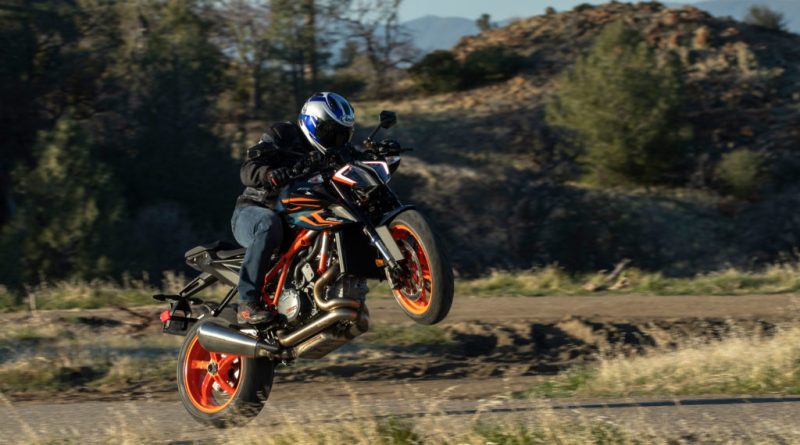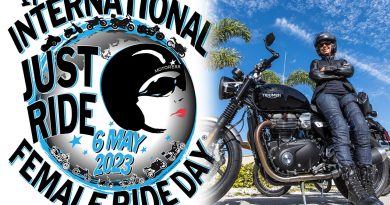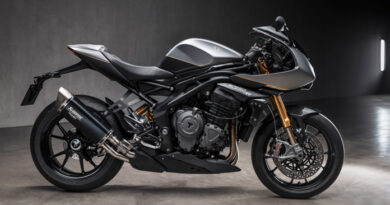2022 KTM 1290 Super Duke R Evo | Road Test Review
The KTM 1290 Super Duke R Evo is a torque monster. Once wheelie control is turned off, it will lift the front wheel on command. Experts only, please. (Photos by Kevin Wing)
Some motorcycles are like Buddha, such as a Gold Wing gliding down the road in near silence, its deep bucket seat cradling your fundament and scarcely a vibration felt at the feet and hands. Others are like mad dogs, snarling and pulling at their chains, ready to rip, tear, and lacerate at a moment’s notice. The original KTM 1290 Super Duke R was pretty much the latter – an idealized naked hyperbike that was introduced in 2014. It had terrific power, satisfying daily-rider ergonomics, and the immediate response that earmarks most race machines. KTM’s “Ready to Race” slogan was aptly fulfilled.
The 1,301cc V-Twin is the star of the show, and the Super Duke’s minimal bodywork and trellis frame does little to hide it.
Now, after eight years of evolution, the latest-gen 1290 Super Duke R Evo goes further with the addition of multi-mode semi-active WP suspension to the KTM’s existing electronic elements, including throttle-by-wire, ride modes (which adjust throttle response and engine power), cornering ABS and traction control, wheelie control, cruise control, and more. Our test bike was equipped with the Tech Pack, a $899.99 option that adds an up/down quickshifter, Motor Slip Regulation (MSR), Suspension Pro, and Track Pack.
The settings may be configured statically or on the fly via multifunction switchgear on the left handlebar. The multilayered menu appears bright and crisp, day or night, on a 4.8-inch color TFT screen, which also includes a hockey-stick-style tachometer, a large digital speedometer, a gear-position indicator, and various annunciators.
With its top-shelf components and comprehensive electronics, the KTM is designed to work equally well on road or track.
FIRE ME UP
Let’s take a ride. There is no traditional ignition key, but rather an electronic transponder with a flip-out key that’s used only to unlock the seat. Approach within a few feet of the bike and the transponder and machine connect wirelessly. A quick press of the master power button on the right handlebar unlocks the fork and gas cap and illuminates the instrument panel.
From there, climb aboard and tag the start button. The highly tuned 1,301cc DOHC 75-degree V-Twin whirs and churns like a Massey Ferguson before firing and settling into a grumbling baritone idle through its enormous stainless headers. Sound pressure recorded at idle at helmet height was 88 decibels. And it gets louder as the revs build, naturally along with wind noise.
Bikes in KTM’s naked and adventure lineups share a common design language, with a vertically split headlight surrounded by a daytime running light.
While the liquid-cooled motor warms up – we found the KTM to be somewhat coldblooded – use the opportunity to configure the electronic engine and chassis parameters for the ride. Which invites a fair question: What kind of ride?
First, select a ride mode: Street, Rain, and Sport modes are standard, while Performance and Track modes are part of the optional Track Pack. Next, select a suspension damping mode: Comfort, Street, and Sport are standard, along with electronically adjustable rear preload (in 2mm increments). Track, Advanced, and Automatic modes are part of the optional Suspension Pro package, which also adds automatic preload leveling with three modes (Low, Standard, and High). You can also turn off both traction control and MSR, turn off the quickshifter, and select an ABS mode (Road or Supermoto, which deactivates ABS at the rear wheel). Or not. Everything can be left in default settings, and you can just grab a gear and go.
The scratch-and glare-resistant TFT display shows speed in a big, bold font with a hockey stick-style tachometer at the top.
It would take much more space than we have available to review all the settings and permutations. It takes some time to get familiar with everything, but for most riders the only settings that will be regularly changed are ride mode and suspension mode. Two customizable profiles allow riders to configure their favorite settings and toggle between them using a switch on the right handlebar. Set it and forget it.
CREATURE COMFORT
Let’s start the ride with the default Street ride mode and the genial Comfort suspension mode to get a baseline understanding of how the semi-active suspension interplays with the carryover electronics. It’s surprising what a pleasant motorcycle the 1290 SD-R Evo is with these soft settings. The suspension – a 48mm WP inverted fork, a linked monoshock, and a single-sided swingarm – is surprisingly comfy. Rowing across town, I found the steering characteristics to be pure joy. The Super Duke is nimble and agreeable for any necessary urban maneuver, from tight turns to quick lane changes to streaking away from offensive traffic.
KTM’s optional Suspension Pro package adds an anti-dive function to the semi-active suspension, preventing the fork from compressing excessively under heavy braking.
GEAR UP
Helmet: Arai Quantum-X
Jacket: Alpinestars Hyper Drystar
Gloves: Alpinestars SMX-2
Pants: Alpinestars Victory Denim
Boots: Alpinestars Faster-3 Rideknit
Switching to the Street suspension mode, the ride quality still proved fine for a rabid naked bike making a claimed 180 hp. So is the engine’s vibration signature, a minor miracle in that the motor is bolted solidly to the space frame’s thin-wall chromoly tubing, and serves as a stressed member. The motocross-style tapered aluminum handlebar wears a pair of 6-oz bar-end mass dampers, which change the bar’s resonant frequency to quell engine-induced vibration in the grips.
The semi-active suspension is made by KTM subsidiary WP. An array of electronic sensors and actuators adjust damping in real-time based on conditions and riding behavior.
Breaking free of town onto a winding two-lane highway, I toggled to Sport mode for both ride and suspension, which firmed up damping characteristics and shock spring preload, quickened throttle response, unleashed full power, and loosened up traction and wheelie control. Like observing a dog perking up its ears, the countenance of the Super Duke noticeably sharpened. Gone was the relaxed, easy cadence of Comfort and Street modes; Sport settings picked up the pace, and so did I. Ride aggressively or casually, Honey Badger don’t care.
Bikes equipped with Suspension Pro have six suspension damping modes and three automatic rear preload modes.
In fact, the twin-spark engine is so flexible, it can just lug around as a torque monster or rage to its 10,250-rpm redline. On Jett Tuning’s dyno, the KTM generated 166 hp at 10,000 rpm and 96 lb-ft of torque at 8,400 rpm at the rear wheel in Sport mode. Horsepower increases steadily with revs, while torque is prodigious throughout the rev range, exceeding 80 lb-ft from 4,000 rpm to redline.
In town, the profiles and contact patches of the Bridgestone Battlax HyperSport S22 radials – 120/70-ZR17 front and fat 200/55-ZR17 rear – proved most agreeable. Linear, predictable, and confidence-inspiring. With their fine-particle silica compound, these refined treads are said to excel in conditions from rain to racetracks. We hit neither on this test, but on every mile of street, road, and freeway we covered, they proved highly satisfying.
A word now about seating. Though dimensionally small, the pilot’s seat feels more standard than sportbike. In other words, it’s just right for most riding activities. (If you want to go sport-touring, check out KTM’s accessory Ergo rider’s and pillion seats.) With no front fairing or windscreen, it’s full wind blast, baby. Complementing the fine steering geometry, the ergonomics are refreshingly sensible compared to superbikes – that is, except for the wide tank/airbox combination that splays knees unnaturally. Further, with its hard finishing panel at the rear, the tank can be a ballbreaker if sudden braking intrudes.
With ride modes, suspension modes, ABS modes, and other settings, the 1290 Super Duke R Evo is highly configurable. Though nicknamed The Beast, the KTM can play many roles, from docile to hyperactive.
ALL IN
For the most fun part of this test, high above the city on empty mountain roads, I toggled to the Track ride mode, which is included as part of the Tech Pack. It maximizes throttle response and power, allows rear wheelspin to be adjusted on the fly over nine levels, and turns off wheelie control. (A more street-oriented Performance mode offers the same features, but also allows riders to use cruise control and the KTM MY RIDE multimedia system.)
In Track mode, everything gets really focused. Throttle response, already made more direct thanks to the new 65-degree quick-turn throttle (reduced by 7 degrees), which also helps reduce wrist angle and elbow drop at full throttle, becomes immediate. The Track suspension mode likewise dramatically firms things up. Although harder-edged, these settings make the Super Duke the ultimate confidence-inspiring machine for attacking road or track. With so much horsepower cued up and lacking the runoff of a modern racetrack, I backed out of this after several miles and reverted to the slightly more docile Sport ride and suspension modes.
Our test of the Super Duke R Evo revealed its complete mastery of all kinds of roads, including fast sweepers and tight corners, off-camber bends, and varied surfaces. Throughout, it required no undue tugging of the handlebar to change directions, engaged in no weird chassis hijinks or bobbles, and stayed faithful and true in whatever conditions appeared. Building such a tenable package is complicated, requiring a refined blend of chassis geometry and stiffness, mass placement, suspension design and tuning, power delivery, adaptive electronics, and way more. And the Bridgestones make it all work, whether at trolling speeds or lightspeed. All primary controls – including throttle, clutch, shifter, and front and rear brakes – are balanced with a well-connected feel.
Switchgear and menus are intuitive.
There are a few demerits, but they’re relatively minor balanced against the total 1290 SD-R Evo package. Some of the handlebar switches are poorly shaped. Particularly egregious is the triangular turnsignal switch; activation feel is fine, but canceling requires pushing what feels like the pointy end of a carpenter’s pencil. Additionally, the headlight high/low switch, toggled by the left forefinger, should be larger, and the horn button is too far from the left thumb. And that 3.2-inch horn! I’m sure it’s stamped with the letters “moo,” emitting barely a plebian bleat no better than a newborn calf’s. Riders deserve better, and not just Super Duke pilots. Lastly, while I was personally happy with the clutch and front brake lever adjustability, the thumbscrews are small, and the adjustment range might not satisfy riders with small hands. Balancing this, the shift lever and rear brake pedal (and fork stops) are also adjustable, albeit with some light wrench work.
The Super Duke R Evo’s optional quickshifter can be turned on or off through the electronics menu. It works spectacularly for rapid upshifts, but is quite sensitive, and so a careless touch of the gear shift lever interrupts power. Admittedly, this only caused problems during particularly aggressive riding. Bottom line, for track duty or raging up a mountain road, the quickshifter is a fine addition; for street riding, though, I was happier deactivating it.
The Beast’s confidence-inspiring handling and stout motor are delightful when bending into corners and exploding out of them.
Part of the Suspension Pro package is a programmable anti-dive feature. I well remember hammering bikes with conventional inverted forks and cursing the nosebleed dives they’d make under hard braking while rushing downhill. No worries with the SD-R Evo, as this feature keeps the chassis more balanced and its rider happy. While eclipsing miles of narrow, twisting downhill road, the 1290’s chassis, Bridgestones, and Brembo brakes with Stylema 4-piston radial front calipers seamlessly mastered the conditions, with excellent feedback and precision. The tires offer an additional advantage of sticking even when they’re cool. Translation: Premium DOT sport tires are a great choice for the wide range of conditions that this improved Super Duke can handle.
TASTES GREAT, LESS FILLING
As much as I enjoyed my time aboard the 1290 while bending it into and out of undulating mountain corners, the KTM proved to be well-mannered on efficient-yet-boring freeways. That’s the real magic of bikes like this with fully customizable riding dynamics. You can tame the power, soften the suspension, and set the cruise control, all while queueing up your favorite song on your smartphone. At 70 mph on the freeway in 6th gear, the engine turns a relaxed 3,500 rpm. The motor seems to be at its smoothest exactly at this point, perfect for touring or droning commutes. On the highway, I found no detriments to the nimble steering geometry; the 1290 tracked beautifully and retained excellent stability.
Modern bikes like this latest Super Duke augment riding fun while reducing certain hassle factors. Pull into a gas station, drop the sidestand, hit the kill switch, and pop open the fuel filler without ever pulling the fob out of your pocket. From the 1290’s 4.2-gal. tank, over a mix of city, freeway, and mowing-down-the-mountain riding, we netted 35 mpg, yielding nearly 150 miles of range. The transponder that allows key-free unlocking, starting, and fueling also simplifies locking. When parked, hit the power button to shut down the bike, then hold it down again to lock the steering.
The Super Duke’s structural chassis uses a tubular-steel trellis main frame, a composite subframe, and a cast-aluminum single-sided swingarm.
During a night ride, I happily discovered that the Super Duke’s twin LED headlights are vastly better than the first Super Duke’s halogen system. KTM surrounded the headlight array (split up the center to feed twin ram-air openings) with a racy illuminated surround in white and orange, KTM’s signature colors. Thoughtfully, the headlight assembly can be quickly removed for track duty with three fasteners and an electrical plug. Same goes for the rear turnsignal/license plate assembly. The TFT display, which automatically adjusts background colors in low-light conditions, seems even more beautifully illuminated at night. The switchgear illumination is modest but gives a general idea where the key switches are.
The 2022 KTM 1290 Super Duke R Evo is a highly attractive motorcycle for riders with serious sporting intentions – and the skills to go with them. For me, it’s close to a perfect streetbike thanks to its instantaneous response, excellent dynamics and feel, agreeable ergonomics, and the added bandwidth of its new semi-active suspension. Let’s be clear though: In its most active state, a Super Duke pushes the boundaries of sanity for streetbike performance. Do we actually need such a device? Nope. Do we want one? Absolutely!
2022 KTM 1290 Super Duke R Evo Specs
Base Price: $19,599
Price as Tested: $20,499 (Tech Pack)
Warranty: 1 yr., 12,000 miles
Website: ktm.com
ENGINE
Type: Liquid-cooled, transverse 75-degree V-Twin
Displacement: 1,301cc
Bore x Stroke: 108.0 x 71.0mm
Compression Ratio: 13.6:1
Valve Train: DOHC w/ 4 valves per cyl.
Valve Insp. Interval: 18,600 miles
Fuel Delivery: Keihin EFI w/ 56mm throttle bodies x 2
Lubrication System: Dry sump, 3.7 qt. cap.
Transmission: 6-speed, hydraulically actuated slip/assist wet clutch
Final Drive: X-ring chain
CHASSIS
Frame: Tubular-steel w/ engine as stressed member, composite subframe & cast aluminum swingarm
Wheelbase: 58.9 in.
Rake/Trail: 25.2 degrees/4.2 in.
Seat Height: 32.8 in.
Suspension, Front: 48mm inverted fork, electronically adj., 4.9 in. travel
Rear: Single shock, electronically adj., 5.5 in. travel
Brakes, Front: Dual 320mm discs w/ 4-piston radial monoblock calipers & ABS
Rear: Single 240mm disc w/ 2-piston caliper & ABS
Wheels, Front: Cast aluminum, 3.50 x 17 in.
Rear: Cast aluminum, 6.00 x 17 in.
Tires, Front: 120/70-ZR17
Rear: 200/55-ZR17
Wet Weight: 466 lbs.
Load Capacity: 471 lbs.
GVWR: 937 lbs.
PERFORMANCE
Horsepower: 165.5 hp @ 10,000 rpm (rear-wheel dyno)
Torque: 95.9 lb-ft @ 8,400 rpm (rear-wheel dyno)
Fuel Capacity: 4.2 gals.
Fuel Consumption: 35.3 mpg
Estimated Range: 149 miles
The post 2022 KTM 1290 Super Duke R Evo | Road Test Review first appeared on Rider Magazine.





